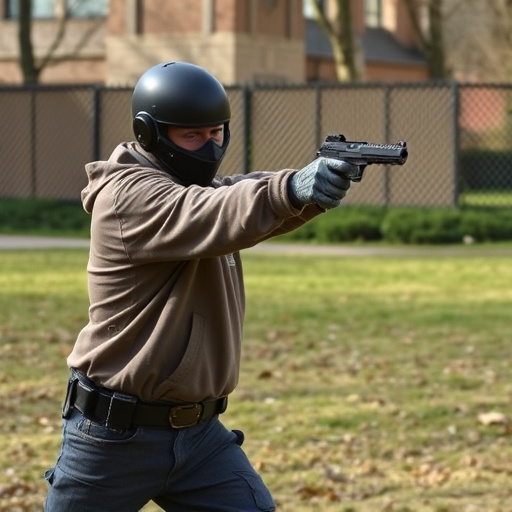Stun devices disable targets through neuromuscular effects, temporarily disrupting nerve impulses and muscle control without causing permanent harm. Ergonomic grip design, such as soft rubber and specialized handgrips, enhances user safety, stability, and precise force application. Modern stun guns maximize these neuromuscular effects through optimized electrode placement and consistent pressure. Comfortable ergonomic features minimize hand strain, enabling maximum impact with each shock under intense pressure. Evaluating comfort involves subjective feedback and objective neuromuscular assessments to ensure safer designs. A firm, stable grip significantly improves accuracy, effectiveness, and quick reactions in self-defense scenarios, maximizing the neuromuscular control of stun devices.
In today’s world, self-defense tools like stun guns are gaining popularity. Comfortable grip designs play a crucial role in enhancing user safety and control over these devices. This article delves into the neuromuscular disruption caused by stun guns, highlighting how ergonomic features impact their effectiveness. We explore various grip designs, evaluating both subjective and objective measures of comfort. By understanding the science behind stun gun inertial forces, we can assess how grip patterns influence accuracy and overall performance, ensuring users have a reliable and safe defense option.
- Understanding Neuromuscular Disruption in Stun Devices
- Comfortable Grip Design: Enhancing User Safety and Control
- The Science Behind Stun Gun Inertial Forces
- Ergonomic Features for Efficient Stun Device Deployment
- Evaluating Comfort Levels: Subjective vs Objective Measures
- Impact of Grip Design on Stun Gun Accuracy and Effectiveness
Understanding Neuromuscular Disruption in Stun Devices

The effectiveness of stun guns lies in their ability to disrupt neuromuscular functions, leading to temporary incapacitation. When deployed, these devices send an electric current through the target’s body, specifically targeting nerve impulses and muscle control centers. This disruption results in a powerful reaction, causing the individual to experience a loss of balance, strength, and coordination. The Neuromuscular Effects of Stun Devices are rapid and intense, ensuring the subject becomes temporarily immobilized, providing users with crucial time to escape potentially dangerous situations.
This mechanism of action is designed to be non-lethal, aiming to subdue rather than cause permanent harm. By focusing on neuromuscular pathways, stun guns can achieve their intended effect while minimizing collateral damage and reducing the risk of serious injury. Understanding these Neuromuscular Effects is paramount in designing more efficient and safe stun gun models, ensuring they remain effective tools for personal safety without causing prolonged or severe disabilities.
Comfortable Grip Design: Enhancing User Safety and Control

A comfortable grip design on stun guns is more than just an aesthetic consideration; it’s a critical factor that enhances user safety and control. The neuromuscular effects of stun devices can lead to temporary incapacitation, but proper grip ensures the user has a secure hold, reducing the risk of dropping or misplacing the device during use. This design aspect plays a pivotal role in empowering individuals to defend themselves effectively, as it allows for precise application and better control over the force applied.
Such designs often incorporate ergonomic principles, focusing on comfort and efficiency. Ergonomic grip features like soft, textured rubber or specialized handgrips can mitigate fatigue during prolonged use, ensuring users maintain their focus and strength. This is particularly important when considering that stun guns are intended for self-defense situations where clear thinking and physical control are paramount.
The Science Behind Stun Gun Inertial Forces

The effectiveness of a stun gun lies in its ability to harness and deliver powerful inertial forces that disrupt the neuromuscular system, rendering an assailant temporarily incapacitated. When activated, a stun gun creates an electric pulse that travels through the device’s electrodes, causing a complex series of physiological responses in the human body. This electric current interferes with nerve impulses, resulting in muscular contractions and loss of balance. The Neuromuscular Effects of Stun Devices are multifaceted, affecting both voluntary and involuntary muscles, leading to profound changes in motor control.
The stun gun’s design plays a crucial role in maximizing these effects by ensuring proper electrode placement and consistent pressure. Modern stun guns are engineered to provide a comfortable grip, allowing users to maintain stability and deliver precise jolts. This ergonomic focus is not merely for user convenience; it enables more effective control over the target area, enhancing the overall impact of the stun device’s neuromuscular effects.
Ergonomic Features for Efficient Stun Device Deployment

Ergonomic features play a pivotal role in making stun gun designs comfortable and efficient for users, especially when considering the neuromuscular effects of these devices. Comfortable grips are designed to minimize strain on the user’s hand and wrist during deployment, ensuring that each shock is delivered with maximum impact. These ergonomic improvements not only enhance usability but also contribute to safer handling, reducing the risk of accidental discharge or improper use.
Effective stun gun deployment requires a swift and precise movement, often in stressful situations. Ergonomic designs cater to this by offering non-slip grips, curved handles, and comfortable palm rests, enabling users to maintain control even under intense pressure. This focus on ergonomics is crucial, as it aligns with the device’s primary function of incapacitating targets through neuromuscular effects, while also prioritizing user safety and comfort.
Evaluating Comfort Levels: Subjective vs Objective Measures

Evaluating comfort levels in stun gun designs is a multifaceted task, as it involves both subjective and objective measures. Subjective assessments, based on user experiences and feedback, play a significant role in understanding how individuals perceive the comfort of a particular device. This includes factors like grip ease, weight distribution, and overall ergonomic design. However, it’s essential to complement these insights with objective evaluations that focus on the neuromuscular effects of stun devices.
Objective measures involve studying the physiological responses of users, such as muscle activation patterns, joint angles, and balance dynamics during interaction with different stun gun designs. By examining these factors, researchers can quantify discomfort levels, identify potential ergonomic hazards, and ultimately guide the development of more comfortable and safer stun guns. This dual approach—combining subjective feedback with objective physiological assessments—provides a comprehensive understanding of comfort levels, ensuring that future designs prioritize both user experience and safety.
Impact of Grip Design on Stun Gun Accuracy and Effectiveness

The design of a stun gun’s grip plays a pivotal role in its overall accuracy and effectiveness, directly impacting how users can deploy the device during critical situations. Ergonomic grip designs are crucial, as they ensure the user maintains a firm and stable hold, allowing for precise control over the weapon. This stability is essential when aiming at specific target zones, particularly in self-defense scenarios where quick reactions and accurate neuromuscular control can make all the difference.
Moreover, considering the neuromuscular effects of stun devices, a well-designed grip facilitates better muscle coordination and reflex response. The user’s ability to grasp and manipulate the stun gun intuitively contributes to faster deployment times, enabling individuals to respond swiftly under stress. This seamless integration between grip design and human biomechanics enhances the overall performance of the stun gun, ensuring its effectiveness as a self-defense tool in various situations.
The evolution of stun gun design, with a focus on comfortable grip mechanisms, significantly enhances user safety and control. By understanding the neuromuscular disruption caused by stun devices and incorporating ergonomic features, manufacturers can ensure effective deployment in real-world scenarios. Comfortable grip designs not only improve accuracy but also contribute to the overall effectiveness of stun guns, making them valuable tools for personal protection. Additionally, evaluating comfort levels through subjective and objective measures provides a comprehensive understanding of user satisfaction and device performance.
